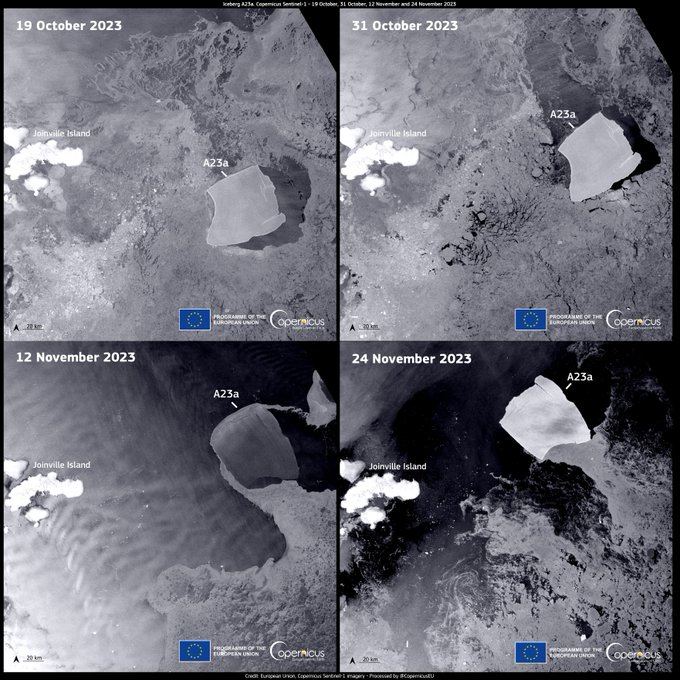
The world's largest iceberg is drifting beyond Antarctic waters and satellites are tracking its movement from space.
The iceberg, called A23a, has broken loose and is moving past the northern tip of the Antarctic Peninsula after being grounded for more than three decades. Recent satellite images reveal that the iceberg, weighing nearly a trillion tons, is drifting at a rate of three miles each day, aided by strong winds and ocean currents, Smithsonian Magazine reported.
The European Space Agency's Copernicus Sentinel-1 mission has been closely tracking the movement of A23a. Copernicus EU shared four separate satellite images comparing the iceberg’s changing position over the last month in a post on X (formally Twitter). The images were taken on Oct. 19 and 31, and Nov. 12 and 24 by the Sentinel-1A satellite.
Related: Wow! Iceberg larger than London breaks off Antarctica (photos)
The British Antarctic Survey shared a timelapse video of the iceberg’' movement using the satellite imagery captured by the Copernicus Sentinel-1 imagery and Google Earth Engine.
#ImageOfTheDay #A23a is the largest #iceberg 🧊 in the worldAfter being stuck on the #Antarctic ocean floor for over 30 years, it has started to drift again in recent months#Sentinel1 🇪🇺🛰️ images from↖️19 and ↗️ 31 October↙️12 and ↘️24 November pic.twitter.com/8MDtOG9mySNovember 25, 2023

"The largest iceberg, A23a, is on the move!” The British Antarctic Survey said in its post on X (formally Twitter). "Here's its journey out of the Weddell Sea after being grounded on the seafloor after calving in August 1986."
Measuring about 1,500 square miles (4,000 sq km), the iceberg is roughly three times the size of New York City and more than twice the size of Greater London. While it split from the Antarctic's Filchner Ice Shelf in 1986, it became stuck to the ocean floor in the Weddell Sea, where it had remained grounded for the last 37 years.
While researchers haven’t identified a specific event that would have initiated the drifting, it is believed that the iceberg may have thinned over time, providing extra buoyancy that’s allowed it to lift off the ocean floor, after which strong winds and ocean currents would be able to move the iceberg along its current trajectory, according to Oliver Marsh, a glaciologist at the British Antarctic Survey.
Astronauts on the International Space Station have also been able to track the iceberg's movement out of the Weddell Sea, which is part of the Southern Ocean between Antarctica and South America. Expedition 70 shared a view of A23a, taken on Nov. 21 from the orbiting lab.

Researchers first noticed A23a moving again in 2020. However, the iceberg has been moving faster in recent months. Now that it has reached the top of the Antarctic Peninsula, the iceberg is expected to head east along the Antarctic Circumpolar Current, which will carry it towards the South Atlantic on a path known as "iceberg alley."
The iceberg's movement has raised some concerns about wildlife, as it could disrupt seals, penguins and other seabirds that breed and forage in the surrounding waters. Therefore, scientists and satellites will continue to follow the iceberg closely.







